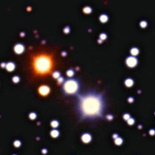
The Jewel Box (NOAO/AURA/NSF)
Astronomy 352K - Fall 2009
GENERAL STELLAR ASTRONOMY
MWF 1:00-2:00 · RLM 15.316B · Unique No. 49530
Professor
RLM 15.312A · (512) 471-1349 [office] 343-0004 [home] · email
Courses - Fall '09 | Course Website
TAs:
See course website
Text:
None! Notes, suggested readings on reserve in libraries, class notes on-line
Grading:
Homework Sets: 40% of grade
Hour tests (3 of them): 40%
Independent topic report 20%
Final Exam: 0% (last Hour Test during the
final exam period)
Students with special needs may request appropriate accommodation;
call UT's office of Services for Students with Disabilities, 471-6259.
Subject Matter, Goals, and Miscellaneous Comments
What is it? Who am I speaking to? Astronomy 352K is a junior/senior-level introduction to stellar astronomy and astrophysics, with emphasis on observational and empirical methods for studying stars via the light they emit. It is designed mainly for upper-division astronomy majors, but it is also suitable for students majoring in closely related fields such as physics, mathematics, or engineering.
Prerequisites? I expect you to have taken Physics 316 (Electricity & Magnetism) and its associated lab course Physics 116L, which have as their prerequisites Physics 301 (Mechanics) and 101L, and relevant math courses. It is acceptable to have taken instead the Engineering Physics courses 303K and 303L, with their lab courses. Astronomy draws on such a wide variety of areas in physics that we cannot expect you to have prior preparation in all of them, and so we will introduce physical ideas and laws as needed. (Examples include the theory of radiation, atomic structure, and statistical mechanics.) We will usually be interested mainly in applying physical principles, rather than in deep and lengthy derivations, and in general the mathematical manipulations expected of you (e.g., on homework sets) will be pretty straightforward.
Background? We do not assume that you have strong (indeed, any!) previous background in astronomy, although many of the students will have previously taken other upper-division astronomy courses or at least had an introductory astronomy course such as AST 307 or 301. If you find that there are gaps in your basic astronomy knowledge, please ask me or the TA to explain or elaborate (either in class or during office hours). You might also find it helpful to consult one of the many fine introductory textbooks that are widely available (I can lend you one of them). It should take you only a few evenings to master all of the relevant material that is contained in these books.